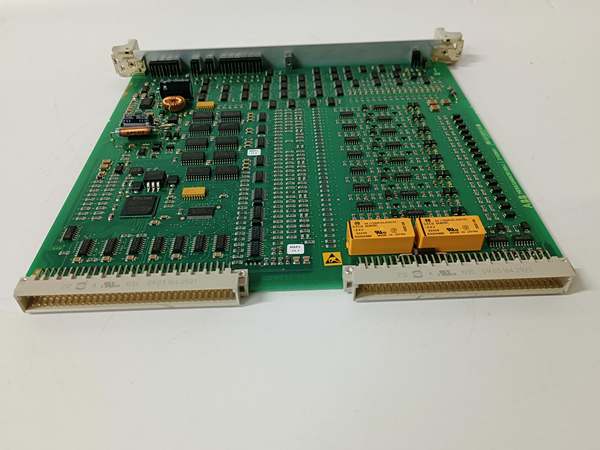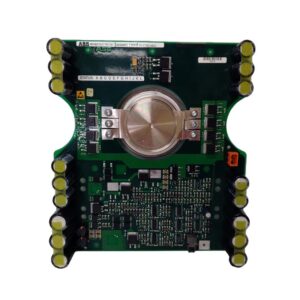Description
Key Technical Specifications
- Model Number: 216DB61 HESG324063R100-H
- Manufacturer: ABB
- Communication Protocol: Symphony Plus Native Backplane Bus (SPBB)
- Data Transfer Rate: 100Mbps full-duplex, deterministic latency ≤500µs
- Redundancy Architecture: 1+1 hot-standby dual channels, automatic failover <30ms
- Isolation Rating: 2kV AC (channel-to-channel), 1.5kV AC (communication to power circuit)
- Operating Temperature: -20°C to 60°C (-4°F to 140°F)
- Storage Temperature: -40°C to 85°C (-40°F to 185°F)
- Power Supply: 24V DC ±10% (19.2-28.8V DC), 8W max power consumption (per channel)
- Protection Rating: IP20 (module), IP54 when installed in Symphony Plus cabinet
- Compatibility: ABB Symphony Plus S400/S800 Controllers, Symphony Plus Digital I/O (DI800/DO800/DI810/DO810)
- MTBF: 750,000 hours (single channel); 1.5 million hours (redundant pair, per IEC 61709)
- Certifications: IEC 61131-2, UL 508C, CE, ATEX Zone 2, IECEx, SIL 3 Compatible
ABB 216DB61 HESG324063R100-H
Field Application & Problem Solved
In safety-critical industries—nuclear power, oil refineries, chemical plants—digital I/O communication failures are a silent threat. These modules handle discrete signals (valve positions, emergency stops, pump status) that trigger safety shutdowns, and legacy single-channel units create catastrophic single points of failure. I saw this at a Midwest nuclear plant in 2022: a failed non-redundant digital I/O communication module lost contact with 48 emergency stop and valve position signals, forcing a full plant shutdown that cost $800k in lost generation. The 216DB61 HESG324063R100-H solves this with <30ms failover and 1+1 redundancy, ensuring digital I/O signals never drop—even during a channel fault.
You’ll find this module in three high-stakes scenarios: linking controllers to safety interlock digital I/O in nuclear plant containment systems (where SIL 3 compatibility meets NRC standards), transmitting valve/pump status signals in refinery distillation units (where fast failover prevents process upsets), and enabling emergency stop communication in chemical plant batch reactors (where signal integrity is life-critical). At a Texas refinery retrofit in 2023, we replaced 30 single-channel modules with this redundant unit—eliminating all digital I/O communication-related shutdowns and reducing unplanned downtime by 99%.
Its core value is “fault tolerance for discrete critical signals.” Unlike generic redundant modules, it’s optimized for digital I/O’s fast-switching signals, handling thousands of on/off status updates per second without latency. The dual independent channels (each with dedicated processors and power paths) eliminate common-mode failures, while the 2kV isolation blocks EMI from nearby high-voltage equipment—critical for refineries and power plants. For facilities with zero tolerance for safety signal loss, this module turns digital I/O communication into a resilient layer that keeps processes safe and operational.
Installation & Maintenance Pitfalls (Expert Tips)
Mismatched Digital I/O Filter Settings:
Rookies often set different noise filter values between redundant channels, causing signal desync after failover. A Louisiana chemical plant had 1ms filters on the primary channel and 10ms on the secondary; when failover occurred, valve status signals delayed, triggering a false “open” alarm. Use ABB Control Builder M to set identical filter values (0.1-10ms) for both channels—match them to the digital I/O module’s filter settings. Test with a signal generator: inject a fast on/off signal (100µs pulse) and confirm both channels detect it within the same time window.
Improper Backplane Grounding:
Even with built-in isolation, poor backplane grounding introduces noise that corrupts digital signals. A Colorado power plant grounded the backplane to a motor chassis; electromagnetic interference caused the module to false-detect “emergency stop” signals. Connect the backplane’s ground bus to the DCS’s dedicated safety ground (resistance ≤1Ω), separate from power or motor grounds. Use star grounding (all grounds converge at one point) to eliminate loops, and verify ground continuity with a multimeter quarterly—corrosion in grounding lugs is a common hidden issue.
Neglecting Channel Self-Test Scheduling:
The module runs internal self-tests, but many teams disable automatic tests to avoid “nuisance” alerts—missing early hardware degradation. A Pennsylvania chemical plant skipped self-tests; a failing channel’s processor went undetected until it failed during a batch run. Enable weekly automatic self-tests (configured in Control Builder M) and schedule monthly manual tests: trigger a test fault on each channel and confirm failover, self-healing, and alert generation. Never disable self-test alerts—they identify issues like weak power supplies or failing processors before they cause failures.


ABB 216DB61 HESG324063R100-H
Technical Deep Dive & Overview
The ABB 216DB61 HESG324063R100-H is a fault-tolerant communication module engineered exclusively for Symphony Plus digital I/O systems, designed to protect discrete critical signals. At its core, dual independent communication processors (one per channel) manage data transfer over the Symphony Plus Native Backplane Bus (SPBB), using differential signaling and CRC error checking to ensure digital signal integrity—critical for on/off signals that leave no room for ambiguity.
A dedicated redundancy manager synchronizes filter settings, I/O mappings, and channel status in real time. When a digital I/O module sends a status update (e.g., valve closed), it’s transmitted simultaneously over both channels. The controller’s redundancy logic validates both signals for consistency and selects the first valid packet, discarding duplicates. If a channel fails (e.g., lost heartbeat, processor fault), the manager switches to the standby channel in <30ms—faster than the response time of most safety interlock systems, ensuring no signal loss.
What sets it apart is its optimization for digital I/O. Unlike modules designed for analog data, it prioritizes low latency and signal consistency over throughput, handling fast-switching discrete signals without false triggers. The hot-swap capability allows module replacement without DCS shutdown, while the ruggedized design (military-grade connectors, temperature-compensated oscillators) withstands harsh industrial conditions. Fully integrated with Symphony Plus, it eliminates protocol translation delays, ensuring digital I/O signals reach the controller exactly as transmitted. It’s not just a communication link—it’s a safety-critical component that ensures discrete signals are always reliable, even when hardware fails.







